12 Animals That Don’t Have a Brain and How The Heck They Survive!
Not all animals have brains, and all of them happen to be sea creatures. You’re probably asking yourself how do you survive without a brain? Well, let’s find out. From the man-o-war to the sea cucumber, here are 12 animals that don’t have a brain and a quick look at how the heck they survive!
What’s In a Brain?
Brains are essentially a group of clustered neurons. Filled with these nerve cells, animals (including humans) control all bodily functions.
Creatures without brains tend to be extremely simple animals. They use rudimentary biological characteristics to survive. Many are immobile, using sensory nerves to “find” food and avoid danger.
Curiously, this is similar to technology. Many of our devices (such as computers and smart phones) do not have brains but use sensors to detect light, movement, chemicals, and more. Brainless animals operate in the same manner, allowing them to do the things they need to survive.
#12 Animals That Don’t Have a Brain: Sea Urchins
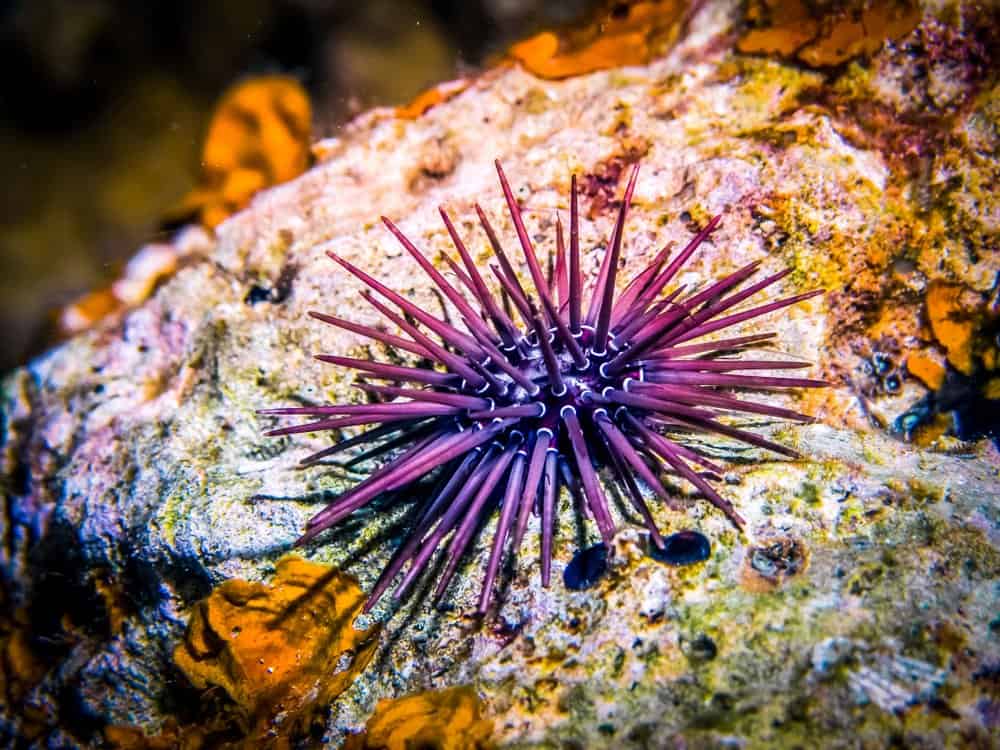
HotFlash/Shutterstock.com
Sea urchins are pointy, spiky animals, and any beachcomber in their bare feet might discover this in the worst way. Fortunately, outside of South Florida, sea urchins are not poisonous.
The creature has an untold number of legs and controls feeding with its water vascular system. That system changes the amount of pressure and water in its body, allowing it to move faster. (The starfish operates the same way.)
The creature’s mouth is beneath it. They expel excrement from the top of their bodies. The sea urchin sits on stones, scraping and feeding on algae. In many ways, this action keeps the ocean clean.
#11 Animals That Don’t Have a Brain: Sea Cucumbers
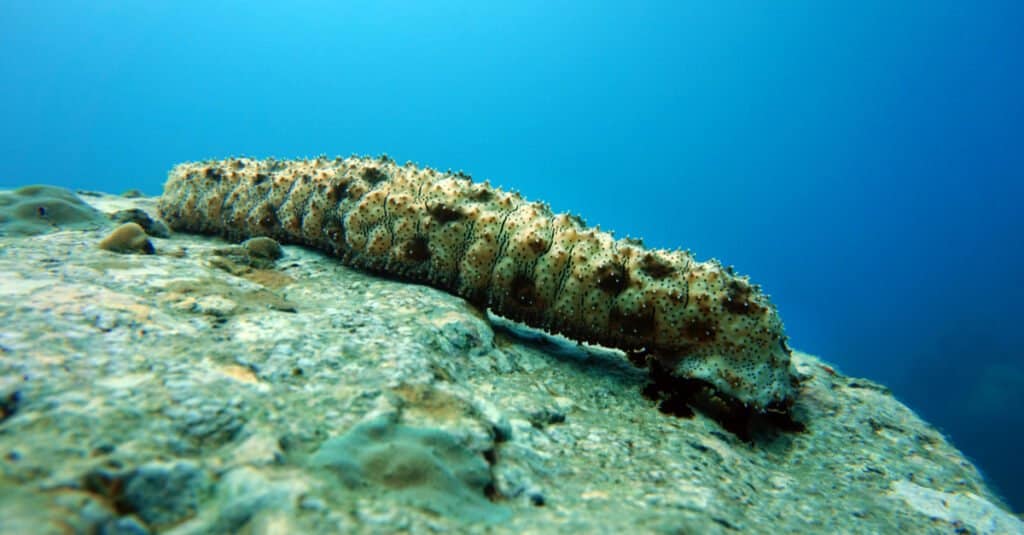
Natalia Siiatovskaia/Shutterstock.com
The wormlike sea cucumber feeds on plankton, and the leathery-skinned animals are everywhere. Sea cucumbers are extremely dangerous but, without a brain, they’re not necessarily a deliberate threat. They are capable of releasing a toxic substance called holothurin, which can blind humans permanently.
There are more than a thousand types of sea cucumbers. Many of the species live in deep water. They can swim up to 3,300 feet, floating back to the bottom of the ocean floor.
Sea cucumbers feed instinctively, using tubular feet around the mouth to catch and take in food. Their diet consists of aquatic invertebrates, algae, and waste. Curiously, while they lack the facility to even realize it, these sea creatures exhibit asexual and sexual reproduction.
#10 Animals That Don’t Have a Brain: Jellyfish
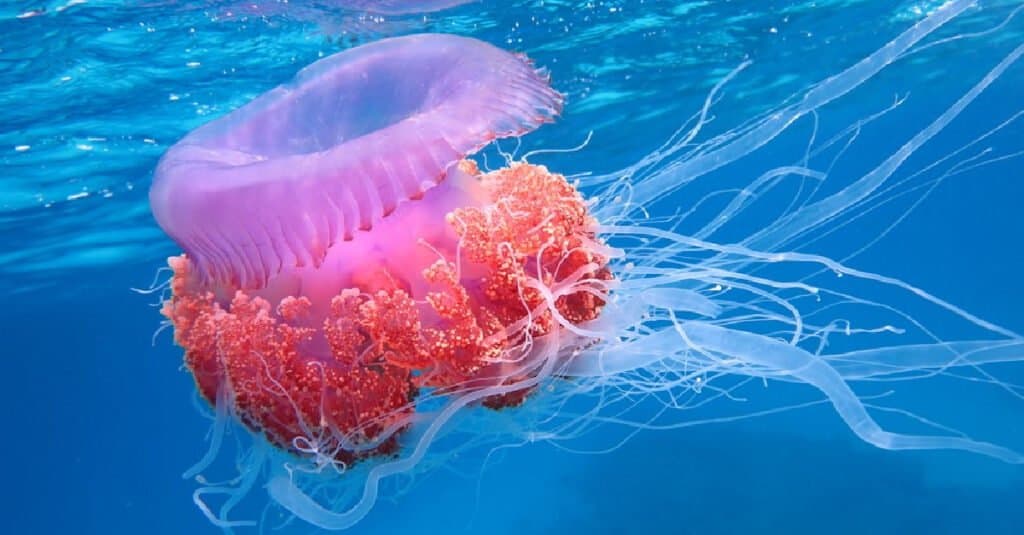
Chai Seamaker/Shutterstock.com
Called “jellies,” this family of translucent creatures is unique. All other creatures without brains tend to be immobile, often spending their entire existence in a single spot. Jellyfish move with the ocean current. They also squirt water that can move them forward.
The jellyfish functions through a network of sensory nerves. Tentacles react to foreign objects with a shooting sting. That sting releases a toxin capable of neutralizing or killing the intruder.
#9 Animals That Don’t Have a Brain: Corals
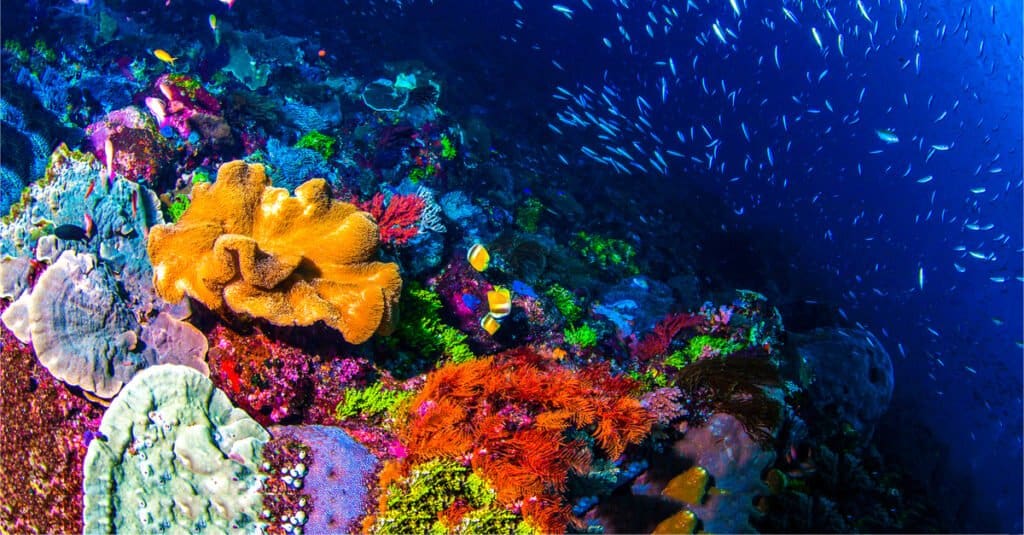
Irina Markova/Shutterstock.com
The coral and jellyfish are part of the Cnidarians family. Their bodies are asymmetric and they both sting their enemies. Categorized as plants, coral is actually a living animal without a brain.
Here’s the great distinction between plants and animals: animals seek food; the plant produces its own. The coral joins the animal in seeking food. They make up small lots of tiny creatures. These coral polyps munch on zooplankton lingering in the ocean. Coral catches the plankton with their retractable tentacles and then they feed.
#8 Animals That Don’t Have a Brain: Starfish
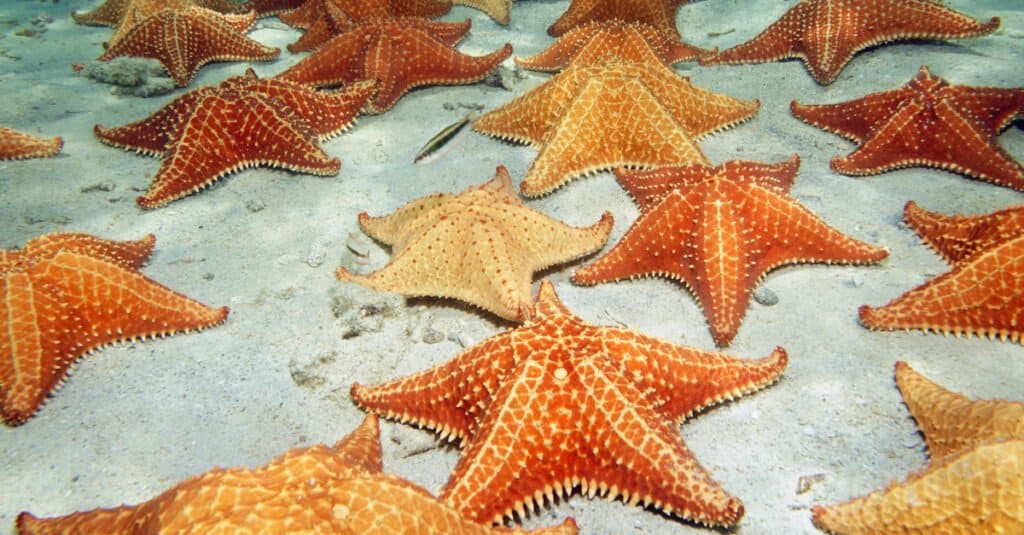
Damsea/Shutterstock.com
The starfish is a cousin of the sea urchin. But — wait for it! — it’s not a fish. The truth is this species can’t swim. Starfish spend all their time at the bottom of the ocean. Though you can find them floating or washed ashore, that’s never by choice!
At the end of each arm, the creatures have tiny eyes that they use to distinguish dark from light. The starfish has no use for a brain. It uses basic sensors to stay alert for enemies and food.
Starfish have five to 40 spiky arms. If a predator should bite off an arm (or two), the animal can regenerate them.
#7 Animals That Don’t Have a Brain: Clams
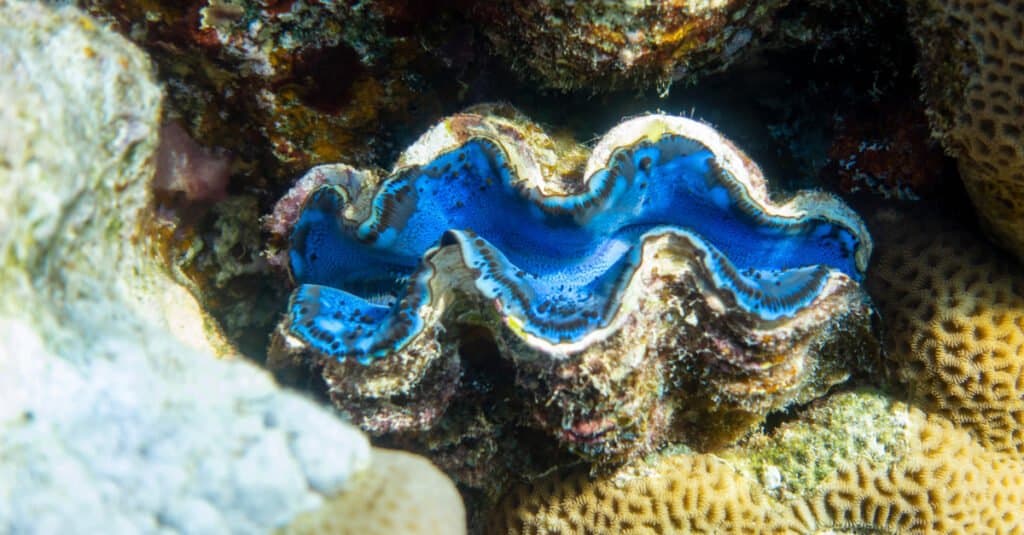
maya_parf/Shutterstock.com
Clams are bivalves, which is a mollusk with a compressed body inside of a pair of hinged shells. Others in the family include oysters, mussels, clams, and scallops. Clams can open and close their shells.
The clam manages to function thanks to its nervous system. They’re popular in the fishing world as clams are easy to catch and live all over the world.
Clams have kidneys, a stomach, mouth, nervous system, and a beating heart.
#6 Animals That Don’t Have a Brain: Man-O-War
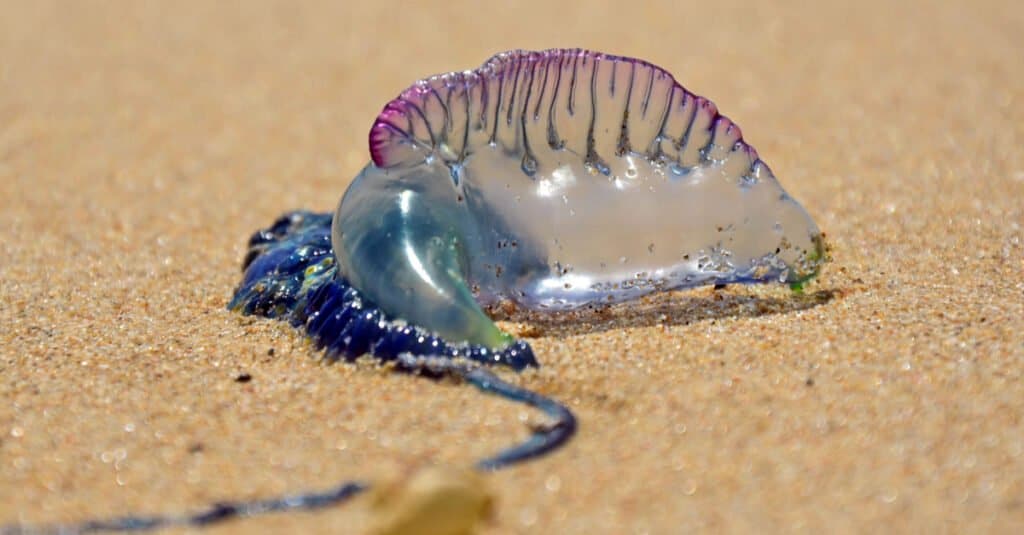
KarenHBlack/Shutterstock.com
Another wobbly-like critter with a venomous sting, the Portuguese man-o-war is up there on the list of strangest animals on the planet.
While we refer to the creature in the singular, we should actually say “man-o-wars.” You see, the animal is actually a colony of polyps, also referred to as zooids. Connected by tissue, the colony cannot survive individually.
The creature has a deadly sting, but that’s useless against its greatest foe, the Sea Turtle. The man-of-war’s stinger cannot penetrate the turtle’s thick skin. Even a sting to the tongue doesn’t deter the sea turtle. The fish also goes to the mat with birds. The man-o-war dives deep when birds approach and shoots gas from its bladders.
#5 Animals That Don’t Have a Brain: Sea Sponges

FP media/Shutterstock.com
Among the animal kingdom’s most primitive animals, the sea sponge stays relatively immobile. It’s the water that moves them around and makes them look like they’re dancing. Their survival centers around filtering detritus from the ocean. They have no brains, organs, neurons, or tissue.
What the sea sponge has in common with humans is a genetic component that resembles synapses. Synapses use neurotransmitters to carry messages across the synaptic gap.
Here’s another curious factoid about this animal: When a foreign object gets into their system, the creature draws in water and then squirts it out through a big sneeze. That’s a recent scientific discovery, and it implies that despite a lack of a brain, the sea sponge is aware of its ecosystem.
#4 Animals That Don’t Have a Brain: Oysters
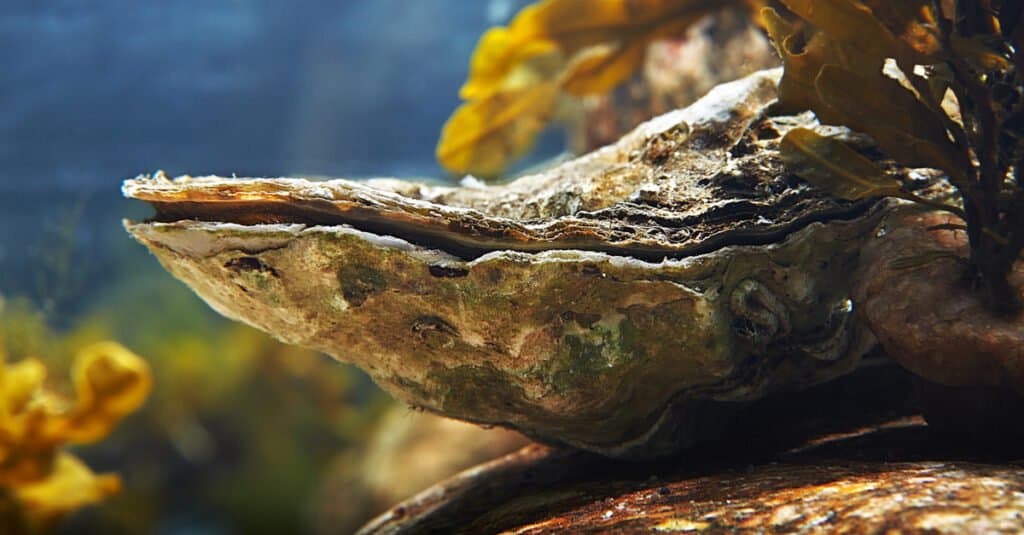
Relative to the clam, the oyster is infamous for enclosing precious pearls in its shell. But it’s a treasure hunt since your odds of finding a perfect pearl are roughly one in a million.
Oysters filter water and remove organic particles — like plankton — to eat them. They can filter up to 50 gallons of water per day, giving them enough food to lasts a while.
#3 Animals That Don’t Have a Brain: Sea Lillies
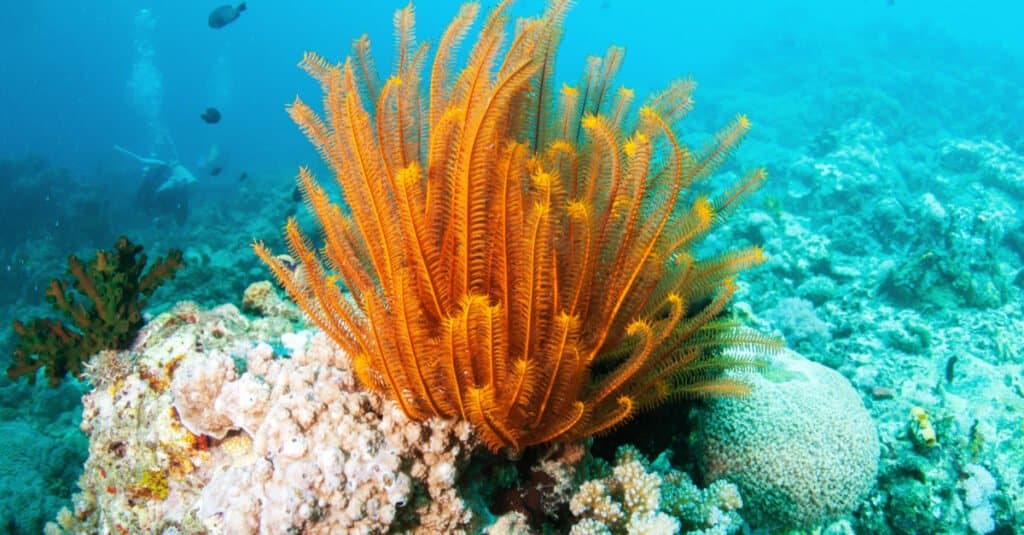
Jung Hsuan/Shutterstock.com
Sea lilies resemble plants with feathery limbs. They sit immobile at the bottom of the ocean for their entire lives. There’s also research that shows the sea lily is capable of floating to a new spot when it can no longer find food. If needed, they can move along at up to 140 miles an hour.
The sea lily is related to the starfish, sea urchin, and sea cucumber. The animal has a small mouth at the center of its body, and it feeds mostly on animal excrement that floats to the ocean bottom. So, like several other animals on this list, the sea lily is instinctively doing its part to keep the ocean clean.
Typically, sea lilies can be as long as 30 inches, though fossils indicate they’ve grown up to 80 feet.
#2 Animals That Don’t Have a Brain: Sea Squirts
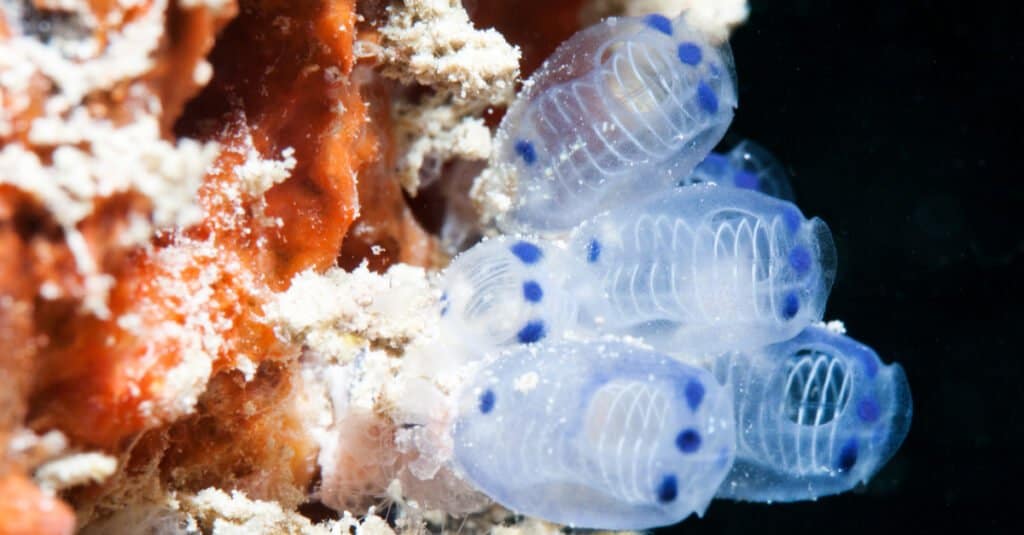
littlesam/Shutterstock.com
Get ready for the weirdest creature on this list. To start, the sea squirt is both male and female. As a hermaphrodite, it has both sexual reproductive organs — the creature does not need a mate to have children. Their tadpole larvae result from sperm and eggs that come from a single animal.
Here’s where it gets weird: in its larva stage, the sea squirt actually has a brain; it’s tiny, but it’s there. However, the creature is unable to find food or eat in its larva form, so it quickly settles in a spot and stays there for the rest of its life. Once the sea squirt has found its “home,” it begins to eat its brain.
Once gone, the creature spends the rest of its lifespan without a brain!
#1 Animals That Don’t Have a Brain: Sea Anemones
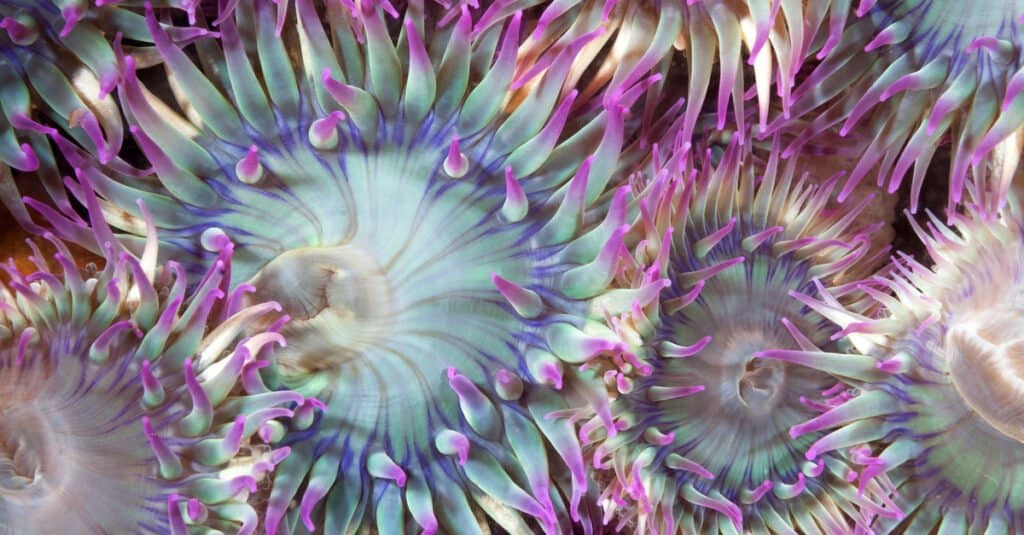
Joe Belanger/Shutterstock.com
The sea anemone is yet another animal that has a plant-like appearance. However, the sea anemone is very much alive and seeking food, which it uses its long tentacles to catch and eat.
A unique characteristic of the sea anemone is its ability to alter shape. This act is accomplished by retracting and turning the long muscles in its tentacles. It’s an amazing thing to see as they change form and shape while swaying in the water. It’s indicative of how, despite the lack of a brain, animals can use sensors to react to their surroundings.
Next Up: The 9 Largest Snails In The World
More from A-Z Animals
Not all animals have brains, and all of them happen to be sea creatures. You’re probably asking yourself how do you survive without a brain? Well, let’s find out. From the man-o-war to the sea cucumber, here are 12 animals that don’t have a brain and a quick look at how the heck they survive!
What’s In a Brain?
Brains are essentially a group of clustered neurons. Filled with these nerve cells, animals (including humans) control all bodily functions.
Creatures without brains tend to be extremely simple animals. They use rudimentary biological characteristics to survive. Many are immobile, using sensory nerves to “find” food and avoid danger.
Curiously, this is similar to technology. Many of our devices (such as computers and smart phones) do not have brains but use sensors to detect light, movement, chemicals, and more. Brainless animals operate in the same manner, allowing them to do the things they need to survive.
#12 Animals That Don’t Have a Brain: Sea Urchins

HotFlash/Shutterstock.com
Sea urchins are pointy, spiky animals, and any beachcomber in their bare feet might discover this in the worst way. Fortunately, outside of South Florida, sea urchins are not poisonous.
The creature has an untold number of legs and controls feeding with its water vascular system. That system changes the amount of pressure and water in its body, allowing it to move faster. (The starfish operates the same way.)
The creature’s mouth is beneath it. They expel excrement from the top of their bodies. The sea urchin sits on stones, scraping and feeding on algae. In many ways, this action keeps the ocean clean.
#11 Animals That Don’t Have a Brain: Sea Cucumbers

Natalia Siiatovskaia/Shutterstock.com
The wormlike sea cucumber feeds on plankton, and the leathery-skinned animals are everywhere. Sea cucumbers are extremely dangerous but, without a brain, they’re not necessarily a deliberate threat. They are capable of releasing a toxic substance called holothurin, which can blind humans permanently.
There are more than a thousand types of sea cucumbers. Many of the species live in deep water. They can swim up to 3,300 feet, floating back to the bottom of the ocean floor.
Sea cucumbers feed instinctively, using tubular feet around the mouth to catch and take in food. Their diet consists of aquatic invertebrates, algae, and waste. Curiously, while they lack the facility to even realize it, these sea creatures exhibit asexual and sexual reproduction.
#10 Animals That Don’t Have a Brain: Jellyfish

Chai Seamaker/Shutterstock.com
Called “jellies,” this family of translucent creatures is unique. All other creatures without brains tend to be immobile, often spending their entire existence in a single spot. Jellyfish move with the ocean current. They also squirt water that can move them forward.
The jellyfish functions through a network of sensory nerves. Tentacles react to foreign objects with a shooting sting. That sting releases a toxin capable of neutralizing or killing the intruder.
#9 Animals That Don’t Have a Brain: Corals

Irina Markova/Shutterstock.com
The coral and jellyfish are part of the Cnidarians family. Their bodies are asymmetric and they both sting their enemies. Categorized as plants, coral is actually a living animal without a brain.
Here’s the great distinction between plants and animals: animals seek food; the plant produces its own. The coral joins the animal in seeking food. They make up small lots of tiny creatures. These coral polyps munch on zooplankton lingering in the ocean. Coral catches the plankton with their retractable tentacles and then they feed.
#8 Animals That Don’t Have a Brain: Starfish

Damsea/Shutterstock.com
The starfish is a cousin of the sea urchin. But — wait for it! — it’s not a fish. The truth is this species can’t swim. Starfish spend all their time at the bottom of the ocean. Though you can find them floating or washed ashore, that’s never by choice!
At the end of each arm, the creatures have tiny eyes that they use to distinguish dark from light. The starfish has no use for a brain. It uses basic sensors to stay alert for enemies and food.
Starfish have five to 40 spiky arms. If a predator should bite off an arm (or two), the animal can regenerate them.
#7 Animals That Don’t Have a Brain: Clams

maya_parf/Shutterstock.com
Clams are bivalves, which is a mollusk with a compressed body inside of a pair of hinged shells. Others in the family include oysters, mussels, clams, and scallops. Clams can open and close their shells.
The clam manages to function thanks to its nervous system. They’re popular in the fishing world as clams are easy to catch and live all over the world.
Clams have kidneys, a stomach, mouth, nervous system, and a beating heart.
#6 Animals That Don’t Have a Brain: Man-O-War

KarenHBlack/Shutterstock.com
Another wobbly-like critter with a venomous sting, the Portuguese man-o-war is up there on the list of strangest animals on the planet.
While we refer to the creature in the singular, we should actually say “man-o-wars.” You see, the animal is actually a colony of polyps, also referred to as zooids. Connected by tissue, the colony cannot survive individually.
The creature has a deadly sting, but that’s useless against its greatest foe, the Sea Turtle. The man-of-war’s stinger cannot penetrate the turtle’s thick skin. Even a sting to the tongue doesn’t deter the sea turtle. The fish also goes to the mat with birds. The man-o-war dives deep when birds approach and shoots gas from its bladders.
#5 Animals That Don’t Have a Brain: Sea Sponges

FP media/Shutterstock.com
Among the animal kingdom’s most primitive animals, the sea sponge stays relatively immobile. It’s the water that moves them around and makes them look like they’re dancing. Their survival centers around filtering detritus from the ocean. They have no brains, organs, neurons, or tissue.
What the sea sponge has in common with humans is a genetic component that resembles synapses. Synapses use neurotransmitters to carry messages across the synaptic gap.
Here’s another curious factoid about this animal: When a foreign object gets into their system, the creature draws in water and then squirts it out through a big sneeze. That’s a recent scientific discovery, and it implies that despite a lack of a brain, the sea sponge is aware of its ecosystem.
#4 Animals That Don’t Have a Brain: Oysters

Relative to the clam, the oyster is infamous for enclosing precious pearls in its shell. But it’s a treasure hunt since your odds of finding a perfect pearl are roughly one in a million.
Oysters filter water and remove organic particles — like plankton — to eat them. They can filter up to 50 gallons of water per day, giving them enough food to lasts a while.
#3 Animals That Don’t Have a Brain: Sea Lillies

Jung Hsuan/Shutterstock.com
Sea lilies resemble plants with feathery limbs. They sit immobile at the bottom of the ocean for their entire lives. There’s also research that shows the sea lily is capable of floating to a new spot when it can no longer find food. If needed, they can move along at up to 140 miles an hour.
The sea lily is related to the starfish, sea urchin, and sea cucumber. The animal has a small mouth at the center of its body, and it feeds mostly on animal excrement that floats to the ocean bottom. So, like several other animals on this list, the sea lily is instinctively doing its part to keep the ocean clean.
Typically, sea lilies can be as long as 30 inches, though fossils indicate they’ve grown up to 80 feet.
#2 Animals That Don’t Have a Brain: Sea Squirts

littlesam/Shutterstock.com
Get ready for the weirdest creature on this list. To start, the sea squirt is both male and female. As a hermaphrodite, it has both sexual reproductive organs — the creature does not need a mate to have children. Their tadpole larvae result from sperm and eggs that come from a single animal.
Here’s where it gets weird: in its larva stage, the sea squirt actually has a brain; it’s tiny, but it’s there. However, the creature is unable to find food or eat in its larva form, so it quickly settles in a spot and stays there for the rest of its life. Once the sea squirt has found its “home,” it begins to eat its brain.
Once gone, the creature spends the rest of its lifespan without a brain!
#1 Animals That Don’t Have a Brain: Sea Anemones

Joe Belanger/Shutterstock.com
The sea anemone is yet another animal that has a plant-like appearance. However, the sea anemone is very much alive and seeking food, which it uses its long tentacles to catch and eat.
A unique characteristic of the sea anemone is its ability to alter shape. This act is accomplished by retracting and turning the long muscles in its tentacles. It’s an amazing thing to see as they change form and shape while swaying in the water. It’s indicative of how, despite the lack of a brain, animals can use sensors to react to their surroundings.
Next Up: The 9 Largest Snails In The World






